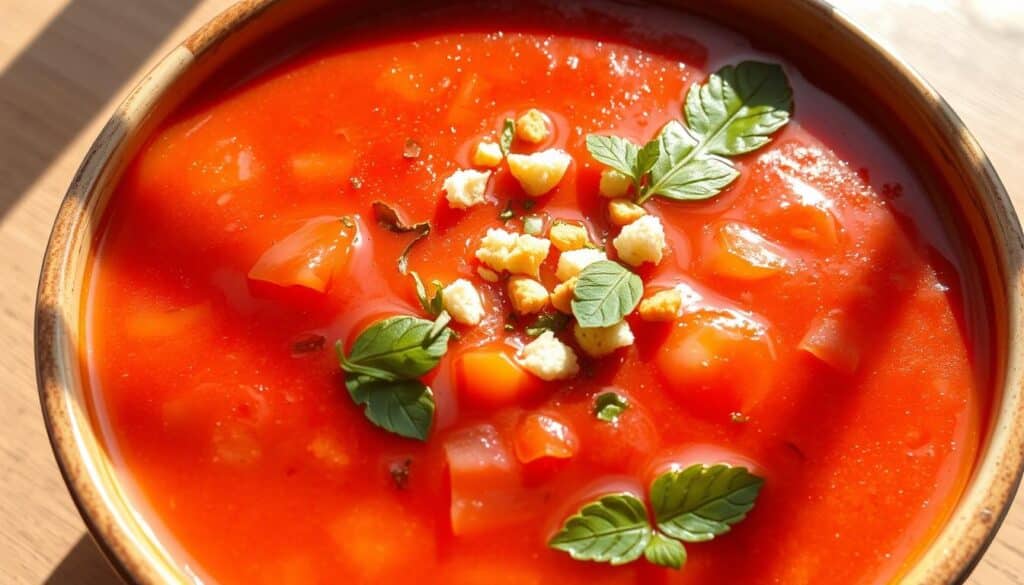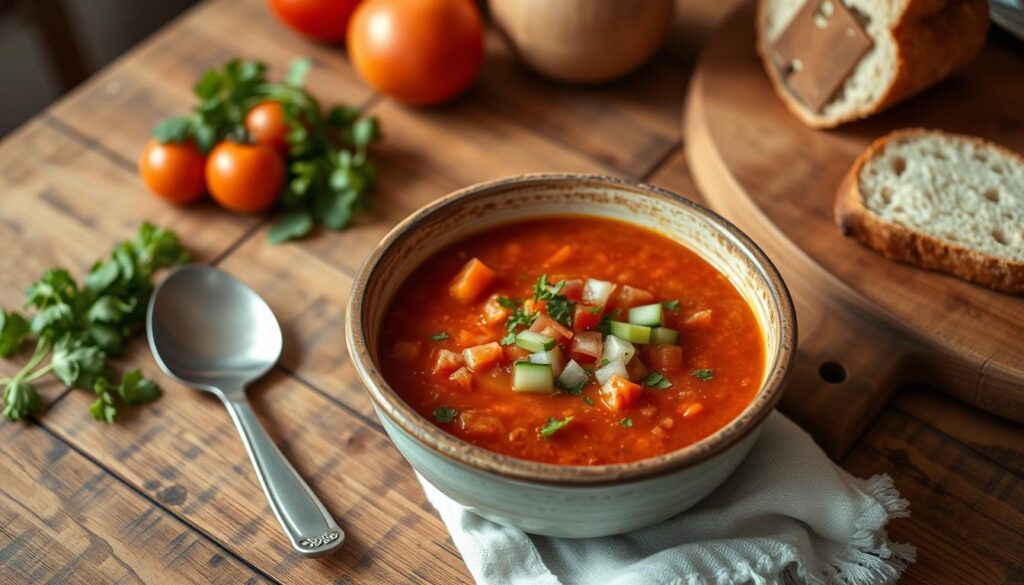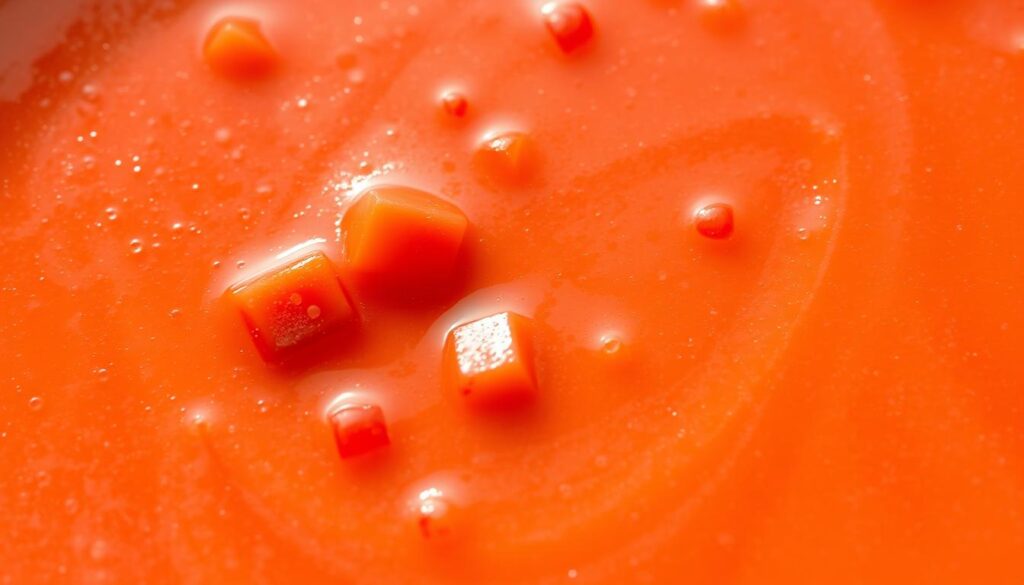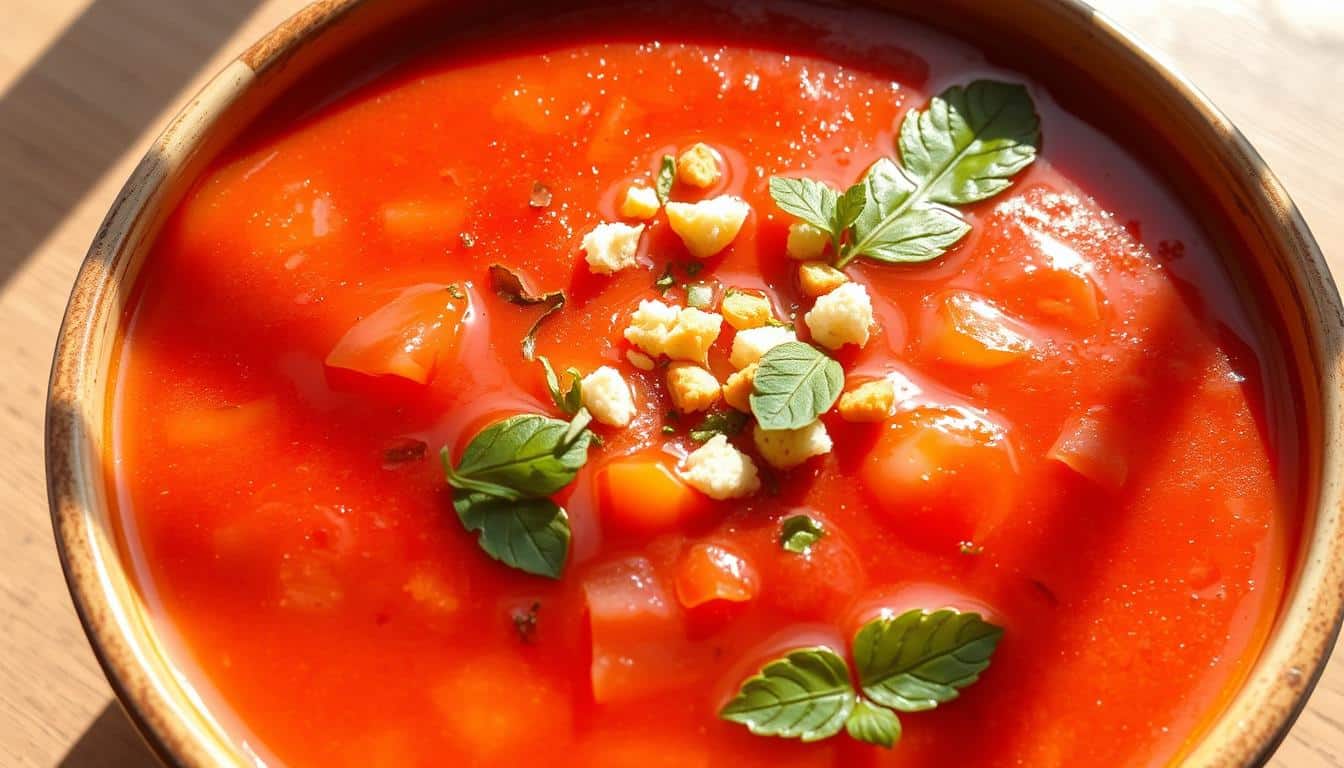There’s something special about a bowl of Gazpacho A Refreshing Cold Tomato soup that instantly transports me to the sun-kissed fields of Andalusia. This vibrant, cold tomato-based soup isn’t just a meal; it’s an experience. Imagine the sweetness of ripe tomatoes, the crunch of fresh cucumber, and the subtle kick of peppers, all blended together with a drizzle of high-quality olive oil. It’s a symphony of flavors and textures that never fails to refresh and delight.
Thank you for reading this post, don't forget to subscribe!What makes gazpacho truly unique is its versatility. While traditional recipes rely on simple ingredients like tomatoes, cucumbers, and peppers, modern twists have introduced a world of possibilities. Whether you prefer it smooth, slightly chunky, or brimming with texture, there’s a version of gazpacho for everyone. The best part? It’s incredibly easy to customize, allowing you to make it your own with a variety of herbs, spices, and garnishes.
In this article, we’ll embark on a journey to explore both the classic and innovative approaches to making gazpacho. We’ll dive into the essential ingredients, the importance of using fresh, seasonal produce, and the techniques that bring this soup to life. By the end, you’ll be ready to create your own delicious gazpacho, perfect for hot summer days or any time you crave a refreshing, healthy meal.

Key Takeaways
- Gazpacho is a refreshing, cold soup made with tomatoes, cucumbers, and peppers, perfect for summer.
- The soup offers a unique texture that can be smooth, chunky, or anywhere in between.
- Quality olive oil is essential for achieving a rich and creamy texture.
- The recipe has evolved to include modern twists while retaining its traditional charm.
- Gazpacho can be customized with various garnishes and ingredients to suit your taste.
- Chilling the soup for at least 2 hours enhances its flavor and texture.
- Gazpacho is a versatile dish that can be served in bowls, mugs, or even over ice with a straw.
Introduction to Gazpacho A Refreshing Cold Tomato Soup
Gazpacho is more than just a dish; it’s a cultural icon that brings people together. Originating from Spain, this refreshing blend of raw vegetables has become a staple in many cuisines worldwide.
What Is Gazpacho?
Gazpacho is a vibrant, cold soup that captures the essence of summer. At its core, it’s a blend of fresh vegetables like bell peppers, onions, and garlic, combined with a touch of oil for richness. The process is simple: chop, blend, and chill. A blender is your best friend here, as it transforms raw ingredients into a smooth, refreshing treat.
Traditional recipes often included bread, but modern versions skip it for a lighter texture. This small change makes a big difference, keeping the focus on the fresh flavors of the vegetables. Quality oil, especially Spanish olive oil, is essential—it enhances the flavor and gives the soup a silky smoothness.
My Personal Journey with This Summer Soup
My love for gazpacho began during a summer trip to Spain. The first sip was like a symphony of flavors—sweet tomatoes, crunchy cucumbers, and a hint of spice from the peppers. Over time, I’ve experimented with different recipes, discovering how versatile gazpacho can be. From smooth to chunky, and even fruit-based variations, there’s always something new to try.
For a traditional approach, check out this easy tomato gazpacho recipe. If you’re looking for something heartier, this chicken in tomato sauce offers a rich twist.
| Ingredient | Role in Gazpacho |
|---|---|
| Bell Pepper | Adds crunch and sweetness |
| Onion | Provides a savory depth |
| Garlic | Enhances flavor profile |
| Olive Oil | Smooths texture and boosts flavor |
History and Origins of Gazpacho
Gazpacho’s story is a fascinating journey through time, tracing back to the sun-drenched regions of Andalusia, Spain. This iconic dish has evolved over centuries, becoming a beloved staple in many cuisines around the world.
Spanish Traditions and Authenticity
Originating in the 16th century, gazpacho was initially a simple blend of bread, garlic, olive oil, vinegar, and salt. Over time, ingredients like tomatoes and cucumbers were added, transforming it into the vibrant dish we know today. Traditionally, gazpacho was a peasant food, providing sustenance for harvesters. The use of fresh, seasonal ingredients ensured it was both nourishing and flavorful.
Modern Twists on a Classic Recipe
Today, chefs around the globe experiment with gazpacho, introducing new ingredients while preserving its authentic essence. From smooth textures to chunky variations, each version offers a unique experience. The dish remains a summer favorite, perfect for hot days when a refreshing meal is needed.

Gazpacho’s cultural significance endures, with each bowl telling a story of tradition and innovation. Whether enjoyed slowly or prepared in minutes with a blender, it continues to captivate palates worldwide.
Gazpacho: A cold soup made with tomatoes, cucumbers, and peppers.
Creating the perfect gazpacho begins with selecting the right ingredients. Each component plays a vital role in balancing flavors and textures, ensuring a refreshing and vibrant result.
Breaking Down the Key Ingredients
The foundation of a great gazpacho lies in its ingredients. Fresh tomatoes provide natural sweetness, while cucumbers add a refreshing crunch. A medium red bell pepper contributes a sweet and slightly smoky flavor, complemented by a dash of vinegar for tanginess.
Salt is essential for balancing the flavors. Use about ¾ of a teaspoon to enhance the dish without overpowering it. A pinch of salt brings out the sweetness of the tomatoes and the crispness of the cucumbers. For added depth, incorporate a teaspoon of garlic and a drizzle of olive oil for richness.
Step-by-Step Recipe Overview
To make gazpacho, start by chopping 2 ½ pounds of ripe tomatoes, ½ pound of cucumber, and 1 medium red bell pepper. Add 1 garlic clove, ¼ cup of olive oil, and 2 tablespoons of red wine vinegar. Blend these ingredients until smooth, then season with ¾ teaspoon of salt. Chill the mixture for at least 2 hours to allow the flavors to meld.
For a classic twist, visit this homemade tomato soup recipe for inspiration on enhancing your gazpacho with additional herbs and spices.
| Ingredient | Role |
|---|---|
| Fresh Tomatoes | Provides sweetness and base flavor |
| Cucumber | Adds refreshing crunch |
| Red Bell Pepper | Contributes sweetness and smokiness |
| Red Wine Vinegar | Enhances tanginess |
| Salt | Balances flavors |
Tips and Techniques for Making Perfect Gazpacho
Mastering the art of gazpacho involves a few key techniques that elevate this simple dish into a culinary delight. By focusing on blending methods and chilling times, you can create a truly exceptional experience.
Blending Methods and Texture Control
Achieving the perfect texture is all about how you blend. Use a food processor to pulse your ingredients, leaving some chunks for a rustic feel. This method ensures a delightful mix of smooth and chunky elements.
- Blend ingredients in stages to maintain texture control.
- Set aside some chopped vegetables for added crunch.
Chilling and Flavor Development
Chilling is crucial for allowing flavors to meld. Let the mixture rest in the fridge for at least an hour, preferably a day, to enhance its taste. A splash of wine can deepen the flavor profile, while grinding spices and measuring garlic with a tablespoon ensures precision.
- Chill for 1 hour minimum, longer for better flavor.
- Add a measured splash of wine for depth.
- Grind spices and measure garlic accurately.

By balancing blending techniques with careful chilling, you’ll achieve a gazpacho that’s both refreshing and flavorful. These tips will guide you to a perfect, mouthwatering result every time.
Serving Suggestions and Variations
Gazpacho is a versatile dish that offers endless possibilities for presentation and customization. Whether you’re looking for a quick summer soup or an elegant appetizer, there’s a way to serve it that suits every occasion.
Garnishing Ideas for an Eye-Catching Presentation
Transform your gazpacho into a visually stunning dish with creative garnishes. A drizzle of olive oil adds a touch of richness, while a sprinkle of fresh herbs like parsley or cilantro introduces vibrant colors. For added texture, consider croutons or a dollop of sour cream. These simple touches elevate the presentation, making it perfect for any gathering.
Pairing with Complementary Dishes
Gazpacho pairs beautifully with crusty bread, making it an ideal accompaniment for dipping. For a more substantial meal, serve it alongside tapas or a fresh green salad. The refreshing quality of the soup complements a variety of dishes, ensuring a well-rounded dining experience.
When it comes to texture and flavor, a splash of sherry vinegar or a drizzle of wine vinegar can add depth. Using a small cup for serving creates an elegant and personal touch, while adding a pound of fresh ingredients like diced avocado or a handful of fresh herbs can dramatically enhance the presentation and flavor.
For inspiration, check out this easy tomato gazpacho recipe that offers a delicious and refreshing base you can customize to your taste.
Conclusion
As I reflect on my journey with this beloved dish, I’m reminded of how it bridges tradition and innovation. Gazpacho, a vibrant blend of fresh vegetables, has evolved from a humble peasant food to a global culinary delight, perfect for warm weather.
At its heart, it’s about authenticity—ripe tomatoes, crisp cucumbers, and sweet peppers, enhanced by quality ingredients like red onion and black pepper. A drizzle of virgin olive oil and a splash of sherry add depth, transforming each serving into a memorable experience.
Whether you garnish with fresh herbs or serve it in a bowl, cup, or even over ice, the dish brings people together. I encourage you to experiment, adding your personal touch to create a unique version. Share your stories and how you serve it—your creativity is the future of this timeless recipe.
FAQ
How precise do I need to be with the measurements in the recipe?
While you can adjust some ingredients to taste, key measurements like the amount of vinegar, oil, and spices should be followed closely to balance the flavors. However, feel free to tweak quantities of vegetables based on your preferences.
Can I use a food processor instead of a blender?
Yes, you can use a food processor. It might not get as smooth as a blender, so you may need to process it in batches and strain it if you prefer a smoother texture.
How do I ensure the best flavor when making gazpacho?
Using fresh, ripe ingredients is key. Letting it chill for at least an hour allows the flavors to meld together beautifully.
What’s the role of bread in the recipe?
Bread helps thicken the gazpacho, giving it a heartier texture. You can omit it for a lighter version or use gluten-free bread if needed.
Can I make gazpacho without any oil?
While olive oil adds a rich flavor, you can reduce the amount or omit it for a lighter version. Keep in mind the flavor may be less robust.
There are no reviews yet. Be the first one to write one.

